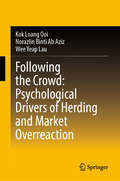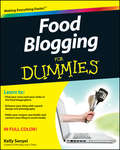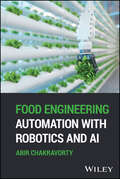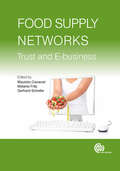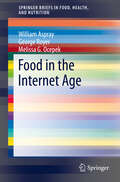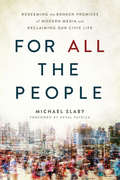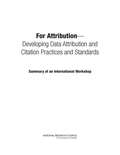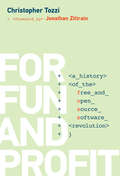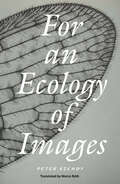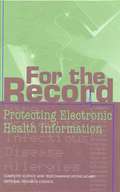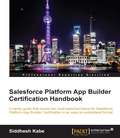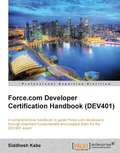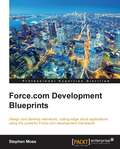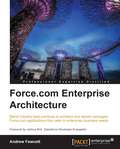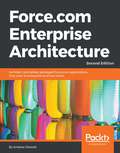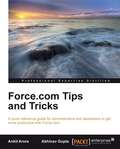- Table View
- List View
Follow Your Arrow
by Jessica VerdiCeCe Ross is kind of a big deal. She and her girlfriend, Silvie, are social media influencers with zillions of fans and followers, known for their cute outfits and being #relationshipgoals.So when Silvie breaks up with her, CeCe is devastated. She's lost her first love, and now she can't help but wonder if she'll lose her followers as well.Things get even messier when CeCe meets Josh, a new boy in town who is very much Not Online. CeCe isn't surprised to be falling for a guy; she's always known she's bi. And Josh is sweet and smart and has excellent taste in donuts... but he has no idea that CeCe is internet-famous. And CeCe sort of wants to keep it that way.But when CeCe's secrets catch up to her, she finds herself in the middle of an online storm, where she'll have to confront the blurriness of public vs. private life, and figure out what it really means to speak her truth.
Follow the Sun: A Field Guide to Architectural Photography in the Digital Age
by James EwingFollow the Sun will guide you through all aspects of architectural photography, from the genre’s rich history to the exciting new approaches brought by the advent of the digital age. It explains how to use the powerful tools of digital photography while employing many of the skills and traditions of the established genre. Written to be accessible to professionals, amateurs, and students alike, this book will be useful for photographers exploring architecture as fine artists, on editorial assignments, or on commercial shoots. Key features include: • Example photographs and diagrams • Historical background of architectural photography • Advice on essential equipment • How to plan a shoot to your advantage • How to use tilt-shift lenses for architecture • Editing workflow and strategies • Interviews with architectural photographers Peter Aaron, Magda Biernat, Ty Cole, and Elizabeth Felicella.
Followed: The Content Creator's Guide to Being Seen, Facing Judgment, and Building an Authentic Personal Brand
by Amanda BucciHere&’s the go-to book for content creators to navigate what it truly means to have a platform: putting yourself out there, letting go of what others think, and claiming the power your authentic self has to offer the world. Since the boom of social media in the mid-2000s, tens of millions of people have started their own platforms in hopes of creating success on their own terms. But with great visibility comes great vulnerability. We become riddled with self-doubt and trapped performing a version of what they believe will be acceptable to others—optimized for more external approval and algorithmic success. What if the mere act of being followed—including the criticism, judgment, and expectation social media creates—could actually become a tool for your personal growth? Enter Followed: The Content Creator's Guide to Being Seen, Facing Judgment, and Building an Authentic Personal Brand. By embracing self-discovery through self-expression, you can learn to see exposure as an opportunity for personal development—and break free from the imaginary boxes that were always too small for you, anyway. As a content creator and well-known business and life coach, Amanda Bucci has dealt with imposter syndrome, oceans of criticism, and multiple identity crises trying to fit into a box. Today, she&’s successfully pivoted her brand to stay aligned with her purpose, having coached hundreds of clients, dozens of companies, and thousands of community members in their journeys of creating success while staying authentic. In Followed, she shares her unique, effective process to: Find your unique niche without feeling imprisoned by your online persona Overcome your fear of judgment, imperfection, and rejection Use exposure as a chance to explore and grow Decrease your social media related stress and anxiety Stop comparing yourself to others and define success on your own terms Empowering, perspective-shattering, and validating, Followed proves that even on social media, it is never necessary to sacrifice self for success.
Following the Crowd: Psychological Drivers of Herding and Market Overreaction
by Wee Yeap Lau Kok Loang Ooi Norazlin Binti Ab AzizThis book delves into a comprehensive exploration of herding and market overreaction combining psychological insights to understand why investors follow the crowd and the investment tips of others. It delves into foundational theories of behavioral finance, examining cognitive biases and emotional factors that drive collective behavior in financial markets. Through detailed case studies, including the 1998 Long-Term Capital Management Collapse, the 2015 Chinese Stock Market Crash, and the 2021 Meme Stock Phenomenon, the book offers real-world examples of herding impacts. It discusses the role of social media and technology, such as AI and machine learning, in shaping investor behavior and provides a global perspective on market reactions across different cultures. Additionally, the book explores regulatory implications and future trends in behavioral finance, making it an essential resource for academics, finance professionals, and advanced students seeking to understand the psychological underpinnings of financial markets.
Food Blogging For Dummies
by Kelly SenyeiBloggers and foodies everywhere will want this full-color bookThe only thing better than cooking and eating is talking about it! Combine your two loves--food and blogging--with this ultimate guide for food bloggers everywhere. Food Blogging For Dummies shows you how to join the blogosphere with your own food blog. This unique guide covers everything: how to identify your niche, design your site, find your voice, and create mouthwatering visuals of your best recipes and menus using dazzling lighting and effects. You'll learn how to optimize your blog for search, connect with social media, take your blog mobile, add widgets, and much more.Walks you through the technicalities of starting your own food blog Explores what you need to consider before your first post ever goes public Shows you how to create lip-smacking food visuals using special lighting and clever effects Explains SEO and how to make sure your site and recipes are searchable Goes into social media and how to use it effectively with your blogHere's everything you need to know about food blogging.
Food Engineering Automation with Robotics and AI
by Abir ChakravortyRevolutionize food manufacturing with the latest in automating technology Virtually every area of industry has been transformed by robotics and AI, which have automated production and increased efficiency in myriad ways. Until recently, food manufacturing was an exception to the trend. At present, however, the food manufacturing industry is in the process of a transformation which will see automation deliver the same levels of productivity and uniformity that have revolutionized other sectors of the economy. Food Engineering Automation with Robotics and AI is a comprehensive introduction to the areas of intersection between cutting-edge technologies and food manufacturing. Beginning with an overview of the basic principles of food engineering, the book then details applications of robotics and AI in this field, along with the way automation is integrated at every stage of food production. The structure of the book seamlessly blends theory and practice to maximize reader capacity to put its lessons into motion. Food Engineering Automation with Robotics and AI readers will also find: Content aligning with several UN Sustainable Development Goals, including Zero Hunger; Industry, Innovation, and Infrastructure; and Responsible Consumption and ProductionReal-world case studies throughout to show automating technologies revolutionizing food productionA consistent focus on sustainable food engineering, with attention to resource conservation, waste reduction, environmental impact mitigation, and more Food Engineering Automation with Robotics and AI is ideal for the growing, global market for food automation technologies in the coming years.
Food Preparation (3rd edition)
by R. T. Miller Robert G. HainesUpdated with 2005 USDA dietary guidelines and the new food pyramid, along with new materials on sanitation, computerized food service management systems, first aid and fire safety procedures, diet trends, and temperatures for cooking, cooling, and hot and cold storage, this comprehensive text emphasizes cost-effective and safe techniques along with advice on professional development. In 30 chapters Haines and Miller cover such topics as careers in food service, sanitation, tools and equipment, safety, nutrition, cooking methods and techniques, breakfast preparation, batter cooking, appetizers, seasonings, salads, cheeses, fruit, vegetables, pasta, soups, meat and fish, breads, cookies, pastries and specialty desserts. The also include hundreds of large-scale recipes (finally we know how to make six Key Lime pies at once), a glossary, and appendices on such topics as the mathematics related to food preparation. They have included a number photographs so well-done readers may be tempted to eat the pages.
Food Styling for Photographers: A Guide to Creating Your Own Appetizing Art
by Linda Bellingham Jean Ann Bybee"You eat with your eyes first," and no one turns a photograph of food into a culinary masterpiece like a food stylist. Food Styling for Photographers is the next best thing to having renowned food stylist Linda Bellingham by your side. Linda has worked with clients Baskin Robbins Ice Cream, McDonald's, Tyson Foods, FritoLay, and many, many more. Professional photographer Jean Ann Bybee has worked with Harry & David, Dominos, Sara Lee, Seven-Up Company, and more. Jean Ann provides a seasoned photographer's point of view with helpful tips throughout.If you are hungry for unique photo assignments and want to expand your portfolio, this guide provides the well-kept secrets of food styling techniques that can make your photos good enough to eat. Each chapter covers step-by-step instructions with mouth-watering photographs illustrating techniques for the creation of hero products that photographers at any level can whip up. Bon Appétit!
Food Supply Networks: Trust and E-business
by Gert Jan Hofstede Rodney Bray Melanie Fritz Maurizio Canavari Nicola Cantore Oliver Meixner Aris Matopoulos Gerhard Schiefer Lisa House Rainer HaasWhen relations are facilitated by communication technologies such as e-business, food supply networks can improve efficiency, flexibility and effectiveness. However, a lack of trust within such transactions can prevent the integration of e-business into this large, economic sector. Using case studies from European countries, chapters discuss trust-building methods for food networks in an e-business environment. Key issues include the influence of cultural disparity and cross-border transactions upon major product groups such as meat, cereal products and fresh produce.
Food Supply Networks: Trust and E-business
by Gert Jan Hofstede Rodney Bray Nicola Cantore Oliver Meixner Aris Matopoulos Lisa House Rainer HaasWhen relations are facilitated by communication technologies such as e-business, food supply networks can improve efficiency, flexibility and effectiveness. However, a lack of trust within such transactions can prevent the integration of e-business into this large, economic sector. Using case studies from European countries, chapters discuss trust-building methods for food networks in an e-business environment. Key issues include the influence of cultural disparity and cross-border transactions upon major product groups such as meat, cereal products and fresh produce.
Food in the Internet Age
by William Aspray George Royer Melissa G. OcepekThis book examines food in the United States in the age of the Internet. One major theme running through the book is business opportunities and failures, as well as the harms to consumers and traditional brick-and-mortar companies that occurred as entrepreneurs tried to take advantage of the Internet to create online companies related to food. The other major theme is the concept of trust online and different models used by different companies to make their web presence seem trustworthy. The book describes a number of major food companies, including AllRecipes, Betty Crocker, Cook's Illustrated, Epicurious, Groupon, OpenTable, and Yelp. The book draws on business history, food studies, and information studies for its approach.
Fools Rush In: Steve Case, Jerry Levin, and the Unmaking of AOL Time Warner
by Nina MunkA carefully explained business debacle.
Fools on the Hill: The Hooligans, Saboteurs, Conspiracy Theorists, and Dunces Who Burned Down the House
by Dana MilbankFrom the halls of Congress, New York Times bestselling author Dana Milbank exposes the chaotic, incompetent and dysfunctional state of the current Republican House—a confederacy of dunces, united by paranoia and conspiracy theories, blundering from one self-inflicted crisis to the next. When Republicans took control of the House in the 2022 midterm elections with a historically slim majority, mayhem began immediately. &“Failed completely.&” &“Can&’t govern.&” &“Broken.&” &“Lunatics.&” &“Embarrassing.&” &“Bunch of idiots.&” And that&’s how House Republicans described themselves. Take it from Marjorie Taylor Greene, who said in May 2024 that &“many Americans in general are sick and tired and fed up with a feckless, useless Republican Party, a conference that does nothing.&” This is the House of George Santos and Jim Jordan, of Lauren Boebert and Matt Gaetz. They investigated space aliens and Hunter Biden&’s art dealer. They punched and they groped. They championed Confederates and insurrectionists—while disparaging the military and sabotaging the economy. They tied up the House so often with far-right fantasies that they produced what was arguably the least effective session of Congress in history. Dana Milbank, widely-read Washington Post columnist, spent a year reporting from inside the Capitol, watching the circus from the front row. The result, Fools on the Hill, is simultaneously horrifying and laugh-out-loud funny. Sadly, it is all true.
Football Analytics with Python & R: Learning Data Science Through the Lens of Sports
by Eric A. Eager Richard A. EricksonBaseball is not the only sport to use "moneyball." American football fans, teams, and gamblers are increasingly using data to gain an edge against the competition. Professional and college teams use data to help select players and identify team needs. Fans use data to guide fantasy team picks and strategies. Sports bettors and fantasy football players are using data to help inform decision making. This concise book provides a clear introduction to using statistical models to analyze football data.Whether your goal is to produce a winning team, dominate your fantasy football league, qualify for an entry-level football analyst position, or simply learn R and Python using fun example cases, this book is your starting place. You'll learn how to:Apply basic statistical concepts to football datasetsDescribe football data with quantitative methodsCreate efficient workflows that offer reproducible resultsUse data science skills such as web scraping, manipulating data, and plotting dataImplement statistical models for football dataLink data summaries and model outputs to create reports or presentations using tools such as R Markdown and R ShinyAnd more
For ALL the People: Redeeming the Broken Promises of Modern Media and Reclaiming Our Civic Life
by Michael SlabyA leader in digital communication and grassroots political campaigns explains how the internet and modern media have undermined America and how we can reclaim our voices for the good of civic life.The creators of the internet promised us jetpacks: better experiences, more choices, and deeper relationships.Built on a diversity of voices, our online freedom was supposed to spark a democratic transformation. But our platforms don't work for us—we're the inventory and our outrage fuels a tech revolution optimized for profit, not civic life.As one of the top digital strategists for Barack Obama's two presidential campaigns, Michael Slaby saw the beginning of a new kind of national division. What he witnessed would spawn the Tea Party movement, upset the 2016 election, and accelerate the polarization of American civic life.Slaby presents the four core areas which can be reclaimed to work better for all of us: platforms, government institutions, corporations, and even the users ourselves. Optimistic, future-focused, and deeply passionate, For ALL the People breaks down how we got here, and how we, the users, can work toward a better democracy through tech.
For Attribution —Developing Data Attribution and Citation Practices and Standards: Summary of an International Workshop
by Paul F. Uhlir RapporteurThe growth of electronic publishing of literature has created new challenges, such as the need for mechanisms for citing online references in ways that can assure discoverability and retrieval for many years into the future. The growth in online datasets presents related, yet more complex challenges. It depends upon the ability to reliably identify, locate, access, interpret and verify the version, integrity, and provenance of digital datasets. <P> Data citation standards and good practices can form the basis for increased incentives, recognition, and rewards for scientific data activities that in many cases are currently lacking in many fields of research. The rapidly-expanding universe of online digital data holds the promise of allowing peer-examination and review of conclusions or analysis based on experimental or observational data, the integration of data into new forms of scholarly publishing, and the ability for subsequent users to make new and unforeseen uses and analyses of the same data - either in isolation, or in combination with other datasets.
For Fun and Profit: A History of the Free and Open Source Software Revolution (History of Computing)
by Christopher TozziThe free and open source software movement, from its origins in hacker culture, through the development of GNU and Linux, to its commercial use today.In the 1980s, there was a revolution with far-reaching consequences—a revolution to restore software freedom. In the early 1980s, after decades of making source code available with programs, most programmers ceased sharing code freely. A band of revolutionaries, self-described “hackers,” challenged this new norm by building operating systems with source code that could be freely shared. In For Fun and Profit, Christopher Tozzi offers an account of the free and open source software (FOSS) revolution, from its origins as an obscure, marginal effort by a small group of programmers to the widespread commercial use of open source software today. Tozzi explains FOSS's historical trajectory, shaped by eccentric personalities—including Richard Stallman and Linus Torvalds—and driven both by ideology and pragmatism, by fun and profit.Tozzi examines hacker culture and its influence on the Unix operating system, the reaction to Unix's commercialization, and the history of early Linux development. He describes the commercial boom that followed, when companies invested billions of dollars in products using FOSS operating systems; the subsequent tensions within the FOSS movement; and the battles with closed source software companies (especially Microsoft) that saw FOSS as a threat. Finally, Tozzi describes FOSS's current dominance in embedded computing, mobile devices, and the cloud, as well as its cultural and intellectual influence.
For an Ecology of Images
by Peter SzendyA new, ecological approach to images by a renowned philosopherWhen Susan Sontag first proposed the idea of an &“ecology of images,&” she meant it as an exhortation to be vigilant against the vast surplus of pictures threatening our ability to truly see. Today, beyond the deep anxieties over a diminishing attention economy, concern focuses on the environmental cost of storing and circulating the digital images that confront us with unprecedented speed.Against the disposable rapidity demanded by digital media, Peter Szendy emphasizes the labor and time required for images to develop and come into view. This inquisitive essay takes us from mimicry in the animal kingdom to the history of the shadow, Pliny&’s story about the birth of painting to Nabokov&’s butterflies, the first use of slo-mo in film to the first aerial photograph.
For the Record Protecting Electronic Health Information
by Committee on Maintaining Privacy Security in Health Care Applications of the National Information InfrastructureWhen you visit the doctor, information about you may be recorded in an office computer. Your tests may be sent to a laboratory or consulting physician. Relevant information may be transmitted to your health insurer or pharmacy. Your data may be collected by the state government or by an organization that accredits health care or studies medical costs. By making information more readily available to those who need it, greater use of computerized health information can help improve the quality of health care and reduce its costs. Yet health care organizations must find ways to ensure that electronic health information is not improperly divulged. Patient privacy has been an issue since the oath of Hippocrates first called on physicians to "keep silence" on patient matters, and with highly sensitive data--genetic information, HIV test results, psychiatric records--entering patient records, concerns over privacy and security are growing.For the Record responds to the health care industry's need for greater guidance in protecting health information that increasingly flows through the national information infrastructure--from patient to provider, payer, analyst, employer, government agency, medical product manufacturer, and beyond. This book makes practical detailed recommendations for technical and organizational solutions and national-level initiatives.For the Record describes two major types of privacy and security concerns that stem from the availability of health information in electronic form: the increased potential for inappropriate release of information held by individual organizations (whether by those with access to computerized records or those who break into them) and systemic concerns derived from open and widespread sharing of data among various parties.The committee reports on the technological and organizational aspects of security management, including basic principles of security; the effectiveness of technologies for user authentication, access control, and encryption; obstacles and incentives in the adoption of new technologies; and mechanisms for training, monitoring, and enforcement.For the Record reviews the growing interest in electronic medical records; the increasing value of health information to providers, payers, researchers, and administrators; and the current legal and regulatory environment for protecting health data. This information is of immediate interest to policymakers, health policy researchers, patient advocates, professionals in health data management, and other stakeholders.
Force.Com Developer Certification Handbook (DEV401) - Second Edition
by Siddhesh KabeThis book is intended for Salesforce developers who are preparing for the Salesforce.com Certified Force.com Developer exam. If you are a Salesforce developer with knowledge of HTML and XML and a basic understanding of the Salesforce application, then this book is for you.
Force.com Developer Certification Handbook (DEV401)
by Siddhesh KabeA practical guide that will help you discover fundamentals for building applications on Force.com without writing a single line of code. If you are new to the Force.com platform and want to learn from scratch, it is advisable that you begin with the first chapter and move on to the last. However, if you are familiar with Force.com and want to understand in detail some aspect of it, you can dip into any chapter. Each certification module is covered in a separate chapter, and is accompanied by questions being asked in the exams. Developers who need to prepare for the Salesforce.com Certified Force.com Developer exam will benefit from this book. This book is ideal for developers who are new to Salesforce CRM and the Force.com platform. It would be advantageous if readers have some familiarity with Salesforce applications and have basic HTML and XML skills. By the end of the book, you will be ready to appear for the exam and develop various applications on the cloud platform.
Force.com Development Blueprints
by Stephen MossThis book consists of an easy-to-follow yet comprehensive set of step-by-step tutorials that will help you gain proficiency in the Force.com platform. If you have some experience with the Force.com platform and are looking to take your skills to the next level, this is the book for you.
Force.com Enterprise Architecture
by Andrew FawcettThis book is for advanced Force.com developers and architects who need to understand the Salesforce platform from the perspective of enterprise-level requirements. You should have an existing understanding of Apex and Visualforce. Those familiar with other enterprise software ecosystems will also find this book ideal as they adopt Force.com.
Force.com Enterprise Architecture - Second Edition
by Andrew FawcettThis book is for advanced Force.com developers and architects who need to understand the Salesforce platform from the perspective of enterprise-level requirements. A prior understanding of Apex and Visualforce is a must. Those familiar with other enterprise software ecosystems will also find this book ideal as they adopt Force.com.
Force.com Tips and Tricks
by Abhinav Gupta Ankit Arora"Force.com Tips and Tricks" is not a complete reference guide for the Force.com platform development but it is a time-saving tips and tricks book that can be very helpful and handy for novice as well as experienced developers. This book would be very useful for Force.com developers who want to extend their Force.com applications using Flex, Apex, and Visualforce. "Force.com Tips and Tricks" is not a bible or a complete reference for the Force.com platform development. The time- saving tips and tricks make this book handy for novice as well as experienced developers. This is basically for Force.com developers, who want to extend their Force.com applications using Flex, Apex, and Visualforce.



